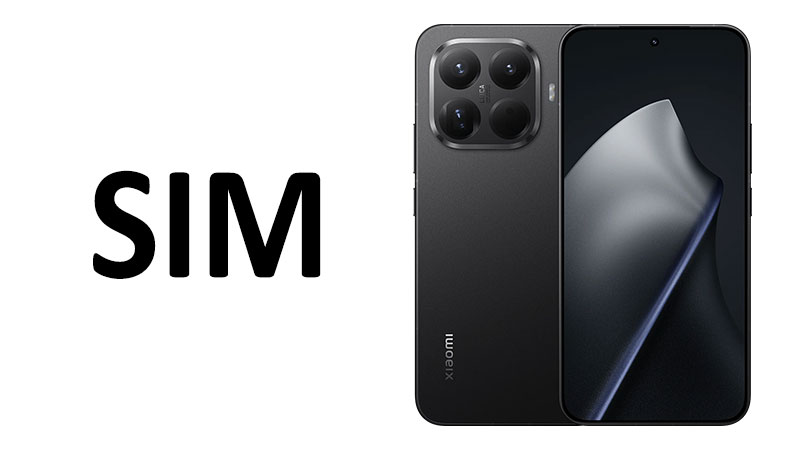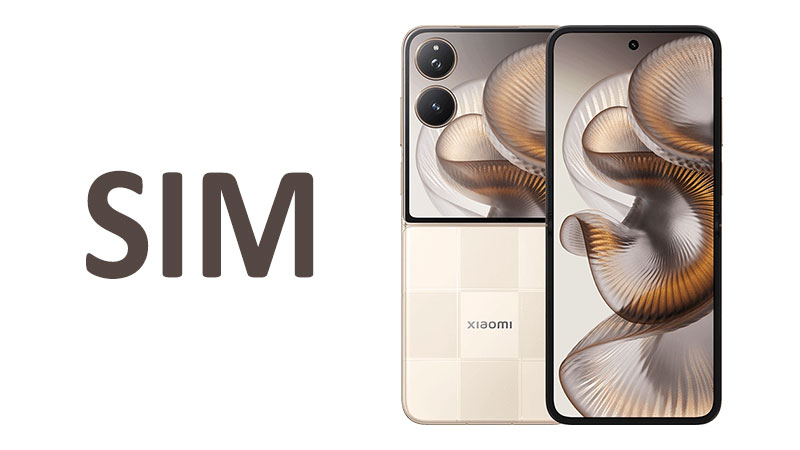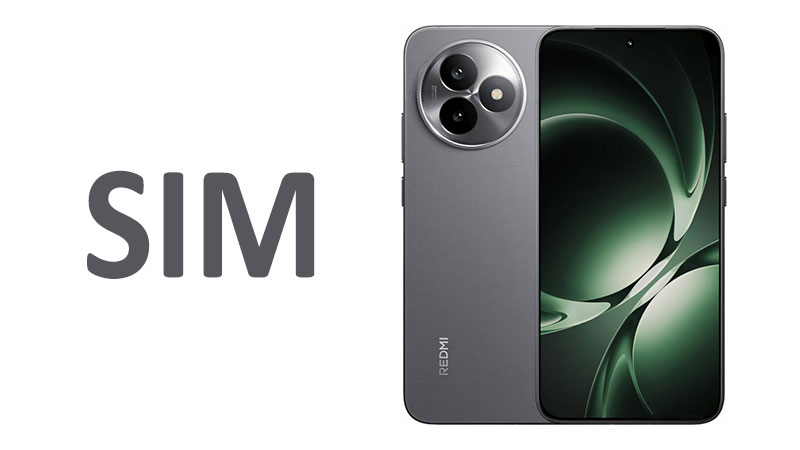The Xiaomi 15T SIM configuration is a crucial specification for global users. Understanding its flexible Dual-SIM and eSIM capabilities is essential. Connectivity defines the modern mobile experience. This flagship device offers advanced options for calling and networking. It supports a remarkable combination of physical Nano-SIMs and digital eSIM profiles. This flexibility caters to international travelers and business professionals. We will review these SIM options in detail. We also explore the comprehensive suite of connectivity standards. This includes 5G cellular speed and cutting-edge Wi-Fi 6E. This guide will help you understand every aspect of the Xiaomi 15T’s networking power.
SIM Configuration Flexibility: The Multi-Option Approach
The Xiaomi 15T provides an advanced, layered SIM system. It offers users unprecedented choice in managing multiple lines. This design supports both traditional physical cards and modern digital profiles. This flexibility is a significant benefit to the user base.
Nano-SIM and Dual Physical SIM
The device supports a dual physical SIM setup. Users can insert two Nano-SIM cards simultaneously. This configuration is widely popular worldwide. It allows users to separate work and personal calls. It also enables using two different mobile carriers. This is often necessary for optimal coverage in varied geographic areas. The Xiaomi 15T features a standard physical tray for these cards.
Pros and Cons of Dual Nano-SIM
A major advantage is simplicity. Most users are familiar with physical SIM cards. They are easy to swap when traveling internationally. A second pro is its universal compatibility. Physical SIMs work with every network globally. However, a drawback is the reliance on physical space. The SIM tray occupies valuable internal volume. Furthermore, losing the physical card can lead to immediate service disruption.
eSIM Adoption and Multiple Digital Profiles
The Xiaomi 15T significantly embraces the digital future of mobile. It supports up to four distinct eSIM profiles. An eSIM is an embedded Subscriber Identity Module. It is integrated directly into the phone’s hardware. This eliminates the need for a removable card. Instead, users download a digital profile from their carrier.
Specialized Comparison: eSIM Capacity
Most competitor phones supporting eSIM allow one or two stored profiles. The Xiaomi 15T expands this to four separate eSIMs. This provides much greater travel freedom. Users can store profiles for their home, work, and multiple travel destinations. This minimizes the need to purchase local physical SIM cards. This massive eSIM capacity is a key differentiating factor.
Maximum Simultaneous Usage: The Dual-Active Limit
It is vital to understand the active limit on the Xiaomi 15T. The phone supports a maximum of two active lines at any given time. These two lines can be any combination of the available options. For example, you can use two physical Nano-SIMs simultaneously. Alternatively, you can combine one physical Nano-SIM with one active eSIM. You may also activate two eSIM profiles at the same time. The total capacity is vast, but the active usage is limited to two lines.
Important Points for Buyers
Buyers must be aware of this dual-active limitation. While you can store up to four eSIMs, only two can be connected to a network. Switching between the inactive eSIMs and the active ones is instantaneous. This process is managed directly within the phone’s software settings. This flexibility is perfect for travelers who switch regions frequently. It saves time and hassle at the airport.
Dual-SIM Dual Standby (DSDS) Functionality
The Xiaomi 15T likely employs DSDS technology. DSDS means both SIMs are on standby to receive calls and messages. However, when one line is actively engaged in a call, the other may become temporarily unavailable. This is a common and efficient design for Dual-SIM phones. It ensures both numbers remain contactable most of the time.
eSIM Technology: A Digital Revolution
The integration of robust eSIM support is a flagship feature. It provides convenience, security, and flexibility for modern smartphone users. This technology is rapidly becoming a standard expectation for premium devices.
Seamless Activation and Provisioning
Activating an eSIM is a remarkably straightforward process. Users typically scan a QR code provided by their mobile carrier. The profile downloads and activates almost instantly. This eliminates the need to visit a physical store for a new SIM card. This instant activation is a major time-saver. It is particularly valuable when changing carriers or switching plans.
Pros and Cons of eSIM
A key pro is enhanced security. eSIMs cannot be physically removed if the phone is lost or stolen. This makes tracking and service suspension easier. Another advantage is the smaller phone footprint. Removing the physical SIM slot frees up internal component space. A con is that not all carriers globally support eSIM technology yet. Furthermore, transferring an eSIM profile to a new device can sometimes be complicated. This process varies depending on the mobile provider.
Specialized Comparison: eSIM Adoption vs Previous Model
Previous generations of the Xiaomi T-series might have lacked eSIM entirely. They may have offered a single eSIM alongside a physical SIM. The Xiaomi 15T’s ability to support multiple stored eSIMs is an evolution. This advanced configuration shows a clear focus on the premium global market. It puts the Xiaomi 15T on par with top competitors in digital connectivity options.
The Travel Advantage
Travelers gain the most significant benefits from eSIM. Instead of juggling tiny physical chips, they manage profiles digitally. Before landing, a user can purchase and activate a local data plan. This avoids expensive roaming charges immediately upon arrival. The ability to keep the home line active via the second slot is also critical. It allows users to receive important messages or calls without fail.
Buyer’s Checklist for eSIM Usage
First, check if your primary carrier supports eSIM. Secondly, confirm the transfer process for your specific provider. Finally, ensure you have a Wi-Fi connection for the initial profile download. These steps guarantee a smooth transition to digital mobile service.
Cellular Connectivity: Embracing the 5G Era
The Xiaomi 15T supports a comprehensive range of cellular technologies. This ensures broad compatibility across different global networks. It is future-proofed with advanced 5G capabilities.
5G Speed and Reliability
The device supports the current 5G standard. This allows for extremely high download and upload speeds. 5G vastly improves data transfer rates compared to older generations. This is critical for high-definition streaming and large file downloads. It also significantly reduces latency. Low latency is essential for competitive online gaming and real-time cloud computing. The Xiaomi 15T’s 5G connectivity is robust and reliable.
Backward Compatibility: GSM, HSPA, and LTE
While 5G is the focus, backward compatibility remains crucial. The Xiaomi 15T seamlessly operates on older network standards. It supports LTE (4G) for fast data in non-5G areas. HSPA (3G) and GSM (2G) support ensure coverage in remote or developing regions. This wide band support guarantees the user remains connected almost everywhere. The device automatically switches to the best available network.
Specialized Comparison: Sub-6 GHz 5G
The Xiaomi 15T likely supports Sub-6 GHz 5G bands. These bands offer broad coverage and excellent penetration through walls. Some competitors focus on mmWave 5G, which is faster but highly localized. Sub-6 GHz provides a more practical, widespread 5G experience. This makes the Xiaomi 15T a more reliable everyday 5G device globally.
Dual-SIM and 5G Simultaneous Use
When using two active SIMs, the Xiaomi 15T manages connectivity intelligently. It allows users to assign which SIM handles data traffic. For instance, SIM 1 can use the high-speed 5G network for downloads. SIM 2 can concurrently handle voice calls over the LTE network. This seamless management of dual connections optimizes user experience. This feature ensures continuous, high-quality connectivity for both lines.
High-Speed Wireless: Wi-Fi 6E and Beyond
Beyond cellular networks, the Xiaomi 15T offers top-tier local wireless connectivity. It incorporates the latest Wi-Fi and Bluetooth standards available. These features enhance device interaction and internet access.
Wi-Fi 6E: The Tri-Band Advantage
The phone supports Wi-Fi 802.11 a/b/g/n/ac/6e standards. Wi-Fi 6E is the latest and most significant feature here. It adds support for the 6 GHz frequency band. This third band operates alongside the traditional 2.4 GHz and 5 GHz bands. The 6 GHz band is less congested than the others.
Benefits of Tri-Band Wi-Fi 6E
Tri-band support offers superior speed and lower latency. It is ideal for high-bandwidth activities like 4K streaming and large file transfers. It requires a compatible Wi-Fi 6E router to function. Users in crowded urban environments benefit greatly from this feature. It helps escape the interference of older, congested Wi-Fi networks. This provides a more stable and faster internet connection at home.
Wi-Fi Direct Functionality
Wi-Fi Direct is also included in the Xiaomi 15T. This feature allows devices to connect directly to each other without a router. It creates an ad-hoc private network between the devices. This is useful for quickly sharing files with a nearby phone or tablet. It facilitates printing directly to a compatible Wi-Fi Direct printer. It offers a fast, local data transfer solution.
Bluetooth 6.0 Features and Use Cases
The Xiaomi 15T utilizes the very recent Bluetooth 6.0 standard. This latest iteration brings several significant improvements. It enhances speed, stability, and energy efficiency. The Bluetooth 6.0 specification includes support for A2DP and LE profiles.
A2DP and LE Profiles Explained
A2DP stands for Advanced Audio Distribution Profile. This ensures high-quality audio streaming to headphones and speakers. LE stands for Low Energy. This profile optimizes power use for smartwatches and fitness trackers. Bluetooth 6.0 provides a more reliable and efficient connection to accessories. It improves the experience with wireless earbuds and car systems.
Specialized Comparison: Bluetooth 6.0 vs Older Versions
Bluetooth 6.0 offers faster pairing times and longer connection ranges. It also handles multiple simultaneous connections better than older versions. Devices using Bluetooth 5.0 or earlier feel slower and less stable by comparison. The upgrade to 6.0 provides a noticeably better wireless accessory experience. This is a key detail for users reliant on wireless audio.
Precision Location and Global Navigation
Accurate positioning is vital for modern smartphone functionality. This includes navigation, location-based services, and emergency functions. The Xiaomi 15T incorporates a highly advanced, multi-band positioning system.
Multi-Band GPS (L1+L5)
The device supports dual-band GPS, specifically L1 and L5 frequencies. Dual-band support significantly improves location accuracy. The L5 frequency signal is more robust and less susceptible to interference. This is particularly useful in dense urban environments. Buildings often block or reflect single-band GPS signals. Multi-band tracking provides quick and highly reliable location fixes.
Supporting Global Constellations
The Xiaomi 15T supports a full array of global navigation systems. This includes the major international systems: BDS, GALILEO, GLONASS, and QZSS. It also includes the regional Indian system, NavIC.
Global Positioning Systems Explained
BDS (BeiDou Navigation Satellite System) is China’s global system. GALILEO is the European Union’s satellite system. GLONASS is Russia’s system. QZSS (Quasi-Zenith Satellite System) is Japan’s regional system. NavIC is India’s regional system. Accessing all these constellations simultaneously increases the number of visible satellites. This redundancy translates directly to improved reliability and precision.
Real-World Impact on Navigation
This comprehensive positioning support offers several real-world benefits. Turn-by-turn navigation is more precise in city centers. Geo-tagging of photos is more accurate. Fitness tracking apps record distance and routes with better fidelity. The inclusion of NavIC (L5) suggests strong performance in the Indian subcontinent. Overall, the Xiaomi 15T provides world-class location services.
Important Points for Readers on Positioning
A buyer should know that this level of satellite support is professional-grade. It goes beyond basic consumer requirements. It guarantees fast initial positioning and robust tracking. This feature makes the Xiaomi 15T an excellent choice for outdoor enthusiasts. It is also ideal for professionals who rely on accurate mapping.
Essential Auxiliary Connectivity Features
The Xiaomi 15T rounds out its connectivity package with several useful auxiliary features. These additions enhance device utility in unique ways. They address needs beyond basic cellular and Wi-Fi data.
NFC for Seamless Payments
The device includes Near Field Communication (NFC) capability. NFC allows for contactless payments through services like Google Pay. It facilitates quick pairing with compatible devices. Furthermore, it enables reading of NFC tags and transit cards. Note that NFC availability can be market or region dependent. Most major global markets will include this essential feature. It ensures quick, secure, and convenient transactions.
Infrared Port Utility
The inclusion of an Infrared (IR) port is a signature Xiaomi feature. The IR port allows the Xiaomi 15T to function as a universal remote control. Users can control home appliances like TVs, air conditioners, and sound systems. This is particularly useful for simplifying home entertainment control. It provides unexpected convenience in daily life. This is a unique differentiator from many competitors.
USB and Data Transfer Protocol
The Xiaomi 15T uses a USB Type-C 2.0 port. This standard handles charging and data transfer. USB Type-C 2.0 offers reliable, if not the fastest, data rates. It supports USB On-The-Go (OTG) functionality. OTG allows the phone to connect directly to external devices. Users can plug in flash drives, keyboards, or other peripherals directly.
Specialized Comparison: USB 2.0 Limitation
Many current flagships now offer faster USB 3.x standards. These newer ports provide much quicker wired data transfer speeds. The USB 2.0 limitation means large file transfers will take longer. Buyers who frequently move massive videos via cable should note this limitation. However, for most users relying on wireless transfer, USB 2.0 is perfectly adequate.
The Absence of a Radio
The specifications confirm that the Xiaomi 15T does not include a dedicated FM radio. This is common among modern premium smartphones. Users must rely on streaming apps for radio content. This typically requires a working cellular or Wi-Fi data connection. It is a minor consideration, but an important one for some users.
Conclusion
The Xiaomi 15T SIM and connectivity features are exceptionally strong. The device offers industry-leading flexibility with its SIM options. Users can choose between two Nano-SIMs, or a combination including up to four stored eSIM profiles. The dual-active limitation is standard and manageable. The phone’s 5G, Wi-Fi 6E, and Bluetooth 6.0 support provide cutting-edge performance. The extensive multi-band positioning ensures global accuracy. Buyers should determine their primary need. If frequent international travel is a concern, the robust eSIM support is invaluable. The combination of features provides a secure, fast, and globally compatible connectivity hub. The Xiaomi 15T is built for the complexity of modern mobile life.
Frequently Asked Questions (FAQ)
1. Can I use three SIM cards at the same time on the Xiaomi 15T?
No, the Xiaomi 15T can only have a maximum of two SIM lines active simultaneously. This limit applies regardless of the type (Nano-SIM or eSIM).
2. Is Wi-Fi 6E much faster than standard Wi-Fi 6?
Wi-Fi 6E adds the less congested 6 GHz band. This provides cleaner channels and lower latency, resulting in better speed and stability.
3. Does the phone support dual-band GPS?
Yes, the device supports multi-band GPS, including the accurate L1 and L5 frequencies. This provides enhanced positioning and navigation.
4. How many eSIM profiles can the Xiaomi 15T store?
The Xiaomi 15T can store up to four separate eSIM profiles digitally. However, only two of these profiles can be active at one time.
5. Why is a high number of positioning systems important?
Supporting multiple systems like GPS, GALILEO, and NavIC increases reliability. It ensures a quick, accurate location fix even in challenging environments.



